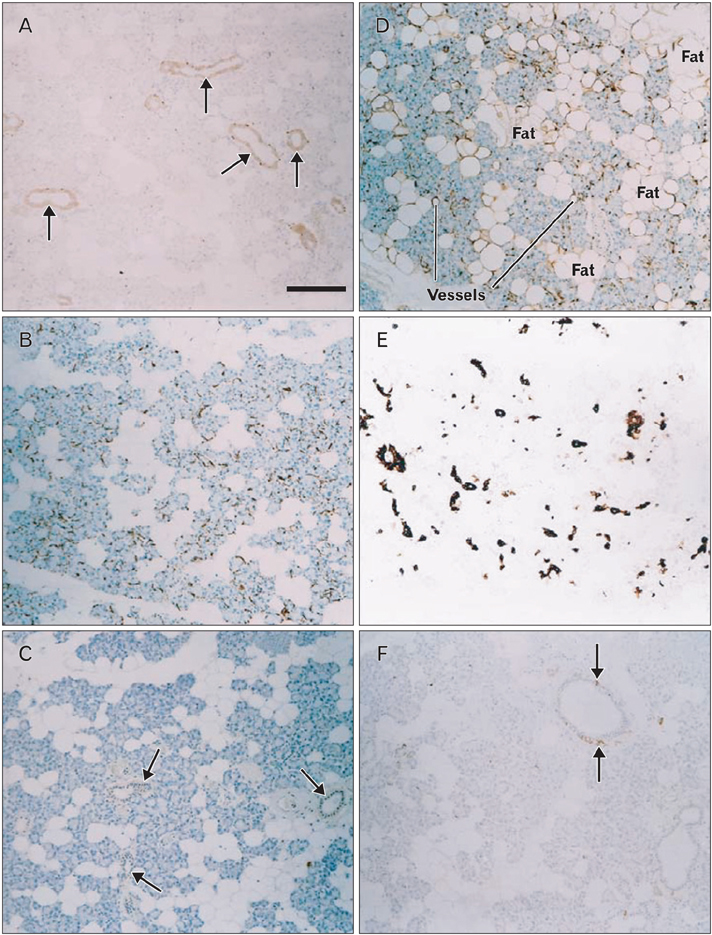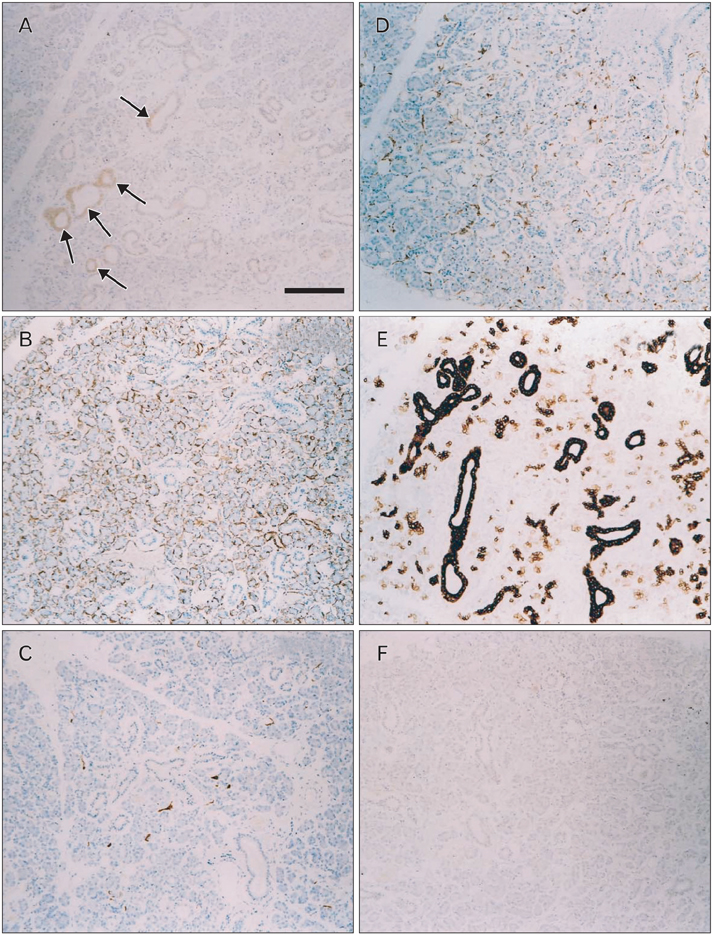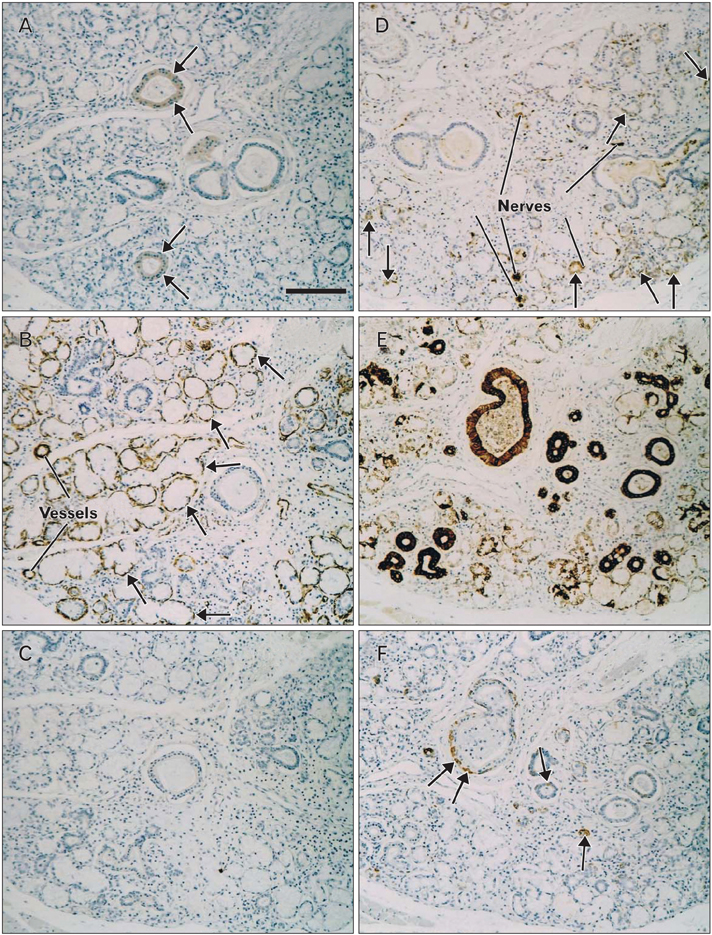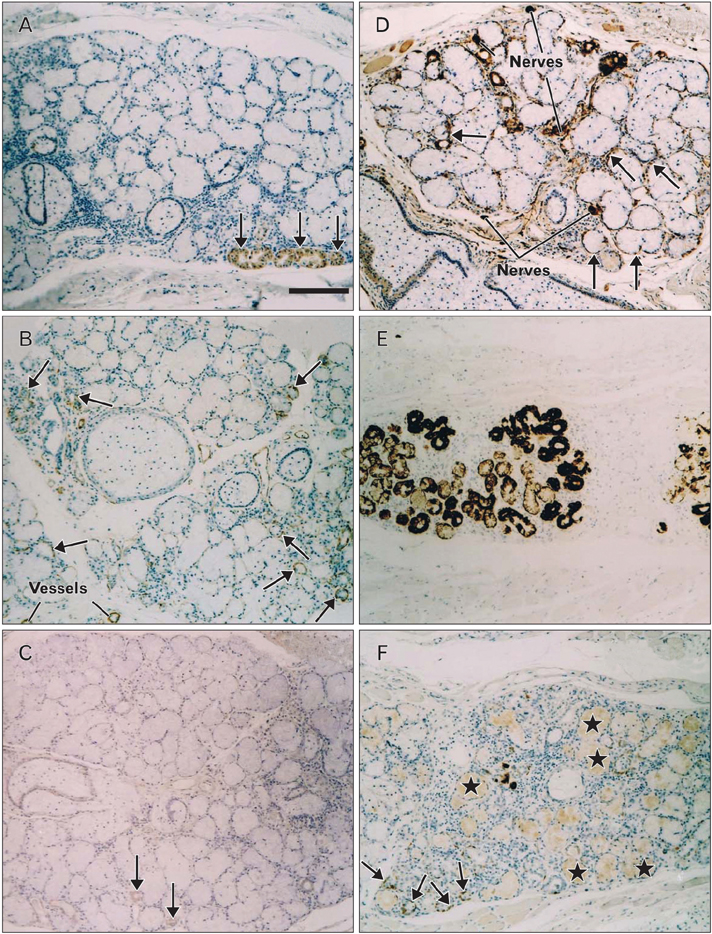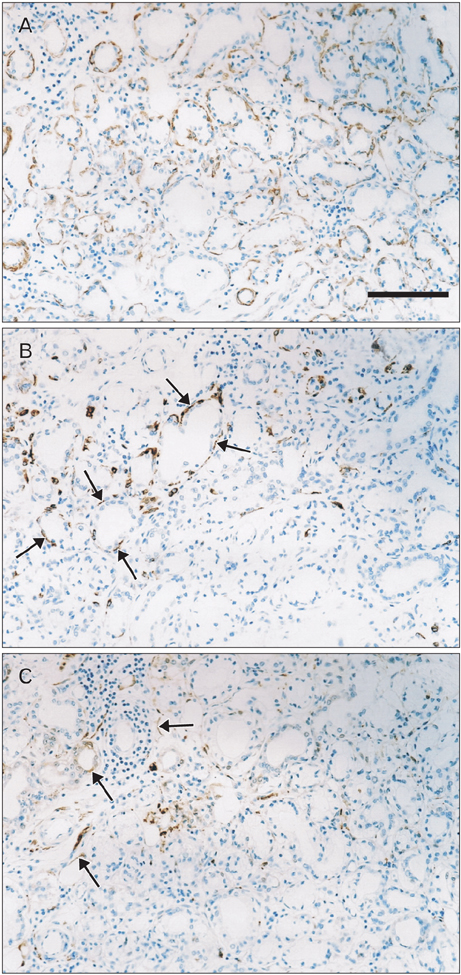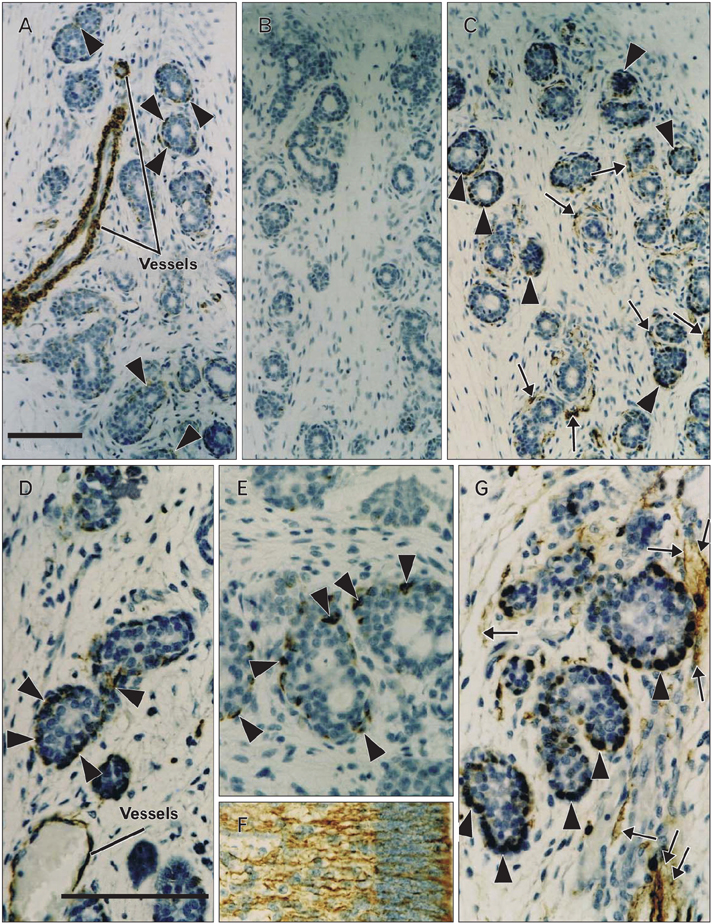Anat Cell Biol.
2013 Jun;46(2):101-112. 10.5115/acb.2013.46.2.101.
Heterogeneity of glandular cells in the human salivary glands: an immunohistochemical study using elderly adult and fetal specimens
- Affiliations
-
- 1Division of Otorhinolaryngology, Sendai Municipal Hospital, Sendai, Japan.
- 2Medical Education Center, Aichi Medical University School of Medicine, Nagakute, Japan. sho5-884@umin.ac.jp
- 3Department of Otolaryngology-Head and Neck Surgery, Tohoku University Graduate School of Medicine, Sendai, Japan.
- 4Department of Anatomy, Chonbuk National University College of Medicine, Jeonju, Korea.
- 5Department of Anatomy, Tokyo Dental College, Chiba, Japan.
- 6Division of Internal Medicine, Iwamizawa Kojin-kai Hospital, Iwamizawa, Japan.
- KMID: 2263102
- DOI: http://doi.org/10.5115/acb.2013.46.2.101
Abstract
- Using immunohistochemical staining for alpha-smooth muscle actin (alpha-SMA), glial fibrillary acidic protein (GFAP), S100 protein (S100), p63, cytokeratin 14 (CK14), and cytokeratin 19 (CK19), we studied acinar and myoepithelial cells of major and minor salivary glands obtained from 14 donated cadavers (78-92 years old) and 5 donated fetuses (aborted at 15-16 weeks of gestation). CK and p63 expression was investigated only in the adult specimens. SMA was detected in all adult glands as well as in fetal sublingual and pharyngeal glands. GFAP expression was seen in a limited number of cells in adult glands, but was highly expressed in fetal pharyngeal glands. S100-positive myoepithelial-like cells were present in adult minor glands as well as in fetal sublingual and pharyngeal glands. Expression of p63 was evident in the ducts of adult glands. CK14 immunoreactivity was observed in a limited number of glandular cells in adults, in contrast to consistent expression of CK19. In both adults and fetuses, a mosaic expression pattern was usually evident for each of the examined proteins. A difference in immunoreactivity for the nerve markers GFAP and S100 was observed between the major and minor glands. Thus, in the present histologic study, we distinguished between the specific gland types on the basis of their immunohistochemical staining. A mosaic expression pattern suggested that the immunoreactivity against nerve protein markers in myoepithelial cells could not be due to the persistence of neural crest remnants or the physiological status of the gland, such as age-related degeneration.
Keyword
MeSH Terms
Figure
Reference
-
1. Gustafsson H, Virtanen I, Thornell LE. Glial fibrillary acidic protein and desmin in salivary neoplasms: expression of four different types of intermediate filament proteins within the same cell type. Virchows Arch B Cell Pathol Incl Mol Pathol. 1989. 57:303–313.2. Lee SK, Kim EC, Chi JG, Hashimura K, Mori M. Immunohistochemical detection of S-100, S-100 alpha, S-100 beta proteins, glial fibrillary acidic protein, and neuron specific enolase in the prenatal and adult human salivary glands. Pathol Res Pract. 1993. 189:1036–1043.3. Murakami M, Makino I, Nin F, Nishiyama Y, Saitou Y, Murakami Y. Immunohistological investigation of the histological origin and differentiation of pleomorphic adenoma of the parotid gland. Nihon Jibiinkoka Gakkai Kaiho. 1993. 96:1235–1245.4. Nakazato Y, Ishida Y, Takahashi K, Suzuki K. Immunohistochemical distribution of S-100 protein and glial fibrillary acidic protein in normal and neoplastic salivary glands. Virchows Arch A Pathol Anat Histopathol. 1985. 405:299–310.5. Okura M, Hiranuma T, Tominaga G, Yoshioka H, Aikawa T, Shirasuna K, Matsuya T. Expression of S-100 protein and glial fibrillary acidic protein in cultured submandibular gland epithelial cells and salivary gland tissues: histogenetic implication for salivary gland tumors. Am J Pathol. 1996. 148:1709–1716.6. Sugiura R, Kuyama K, Utsunomiya T, Morikawa M, Fukumoto M, Yamamoto H. Myoepithelioma arising from the buccal gland: histopathological and immunohistochemical studies. J Oral Sci. 2000. 42:39–42.7. Angiero F, Sozzi D, Seramondi R, Valente MG. Epithelial-myoepithelial carcinoma of the minor salivary glands: immunohistochemical and morphological features. Anticancer Res. 2009. 29:4703–4709.8. Ogawa I, Nishida T, Miyauchi M, Sato S, Takata T. Dedifferentiated malignant myoepithelioma of the parotid gland. Pathol Int. 2003. 53:704–709.9. Santos EP, Cavalcante DR, Melo AU, Pereira JC, Gomes MZ, Albuquerque RL Jr. Plasmacytoid myoepithelioma of minor salivary glands: report of case with emphasis in the immunohistochemical findings. Head Face Med. 2011. 7:24.10. Kurita T, Cunha GR. Roles of p63 in differentiation of Mullerian duct epithelial cells. Ann N Y Acad Sci. 2001. 948:9–12.11. Kurita T, Cunha GR, Robboy SJ, Mills AA, Medina RT. Differential expression of p63 isoforms in female reproductive organs. Mech Dev. 2005. 122:1043–1055.12. Martens JE, Smedts F, van Muyden RC, Schoots C, Helmerhorst TJ, Hopman A, Ramaekers FC, Arends JW. Reserve cells in human uterine cervical epithelium are derived from mullerian epithelium at midgestational age. Int J Gynecol Pathol. 2007. 26:463–468.13. Shapiro E, Huang H, McFadden DE, Masch RJ, Ng E, Lepor H, Wu XR. The prostatic utricle is not a Mullerian duct remnant: immunohistochemical evidence for a distinct urogenital sinus origin. J Urol. 2004. 172(4 Pt 2):1753–1756.14. Ianez RF, Buim ME, Coutinho-Camillo CM, Schultz R, Soares FA, Lourenco SV. Human salivary gland morphogenesis: myoepithelial cell maturation assessed by immunohistochemical markers. Histopathology. 2010. 57:410–417.15. Jain R, Fischer S, Serra S, Chetty R. The use of cytokeratin 19 (CK19) immunohistochemistry in lesions of the pancreas, gastrointestinal tract, and liver. Appl Immunohistochem Mol Morphol. 2010. 18:9–15.16. Iwasaki S, Aoyagi H, Yoshizawa H. Localization of keratins 13 and 14 in the lingual mucosa of rats during the morphogenesis of circumvallate papillae. Acta Histochem. 2011. 113:395–401.17. Lourenço SV, Lima DM, Uyekita SH, Schultz R, de Brito T. Expression of beta-1 integrin in human developing salivary glands and its parallel relation with maturation markers: in situ hybridisation and immunofluorescence study. Arch Oral Biol. 2007. 52:1064–1071.18. Martins MD, Cavalcanti de Araujo V, Raitz R, Soares de Araújo N. Expression of cytoskeletal proteins in developing human minor salivary glands. Eur J Oral Sci. 2002. 110:316–321.19. Chi JG. Prenatal development of human major salivary glands. Histological and immunohistochemical characteristics with reference to adult and neoplastic salivary glands. J Korean Med Sci. 1996. 11:203–216.20. Hayashi S, Murakami G, Ohtsuka A, Itoh M, Nakano T, Fukuzawa Y. Connective tissue configuration in the human liver hilar region with special reference to the liver capsule and vascular sheath. J Hepatobiliary Pancreat Surg. 2008. 15:640–647.21. Tucker AS. Salivary gland development. Semin Cell Dev Biol. 2007. 18:237–244.22. Mori M, Murase N, Hosaka M, Orito T. Immunohistochemical expression of S-100 protein in reactive and neoplastic myoepithelial cells of variant salivary pleomorphic adenomas. Acta Histochem Cytochem. 1986. 19:231–240.23. Dardick I, Stratis M, Parks WR, DeNardi FG, Kahn HJ. S-100 protein antibodies do not label normal salivary gland myoepithelium. Histogenetic implications for salivary gland tumors. Am J Pathol. 1991. 138:619–628.24. Huang JW, Hashimura K, Sakamoto F, Yuba R, Mori M, Yoneda K, Yanagihara M, Mori S. Heterogeneity and multiple expression of intermediate filament proteins, S-100 protein and neuron specific enolase in skin mixed tumor. Anticancer Res. 1992. 12:1107–1114.25. Martínez-Madrigal F, Bosq J, Casiraghi O. Sternberg SS, editor. Major salivary glands. Histology for Pathologists. 1997. 2nd ed. Philadelphia: Lippincott-Raven;405–429.26. Jin ZW, Song KJ, Lee NH, Nakamura T, Fujimiya M, Murakami G, Cho BH. Contribution of the anterior longitudinal ligament to ossification and growth of the vertebral body: an immunohistochemical study using the human fetal lumbar vertebrae. Surg Radiol Anat. 2011. 33:11–18.27. Miyako H, Suzuki A, Nozawa-Inoue K, Magara J, Kawano Y, Ono K, Maeda T. Phenotypes of articular disc cells in the rat temporomandibular joint as demonstrated by immunohistochemistry for nestin and GFAP. J Anat. 2011. 219:472–480.28. Lourenço SV, Coutinho-Camillo CM, Buim ME, Uyekita SH, Soares FA. Human salivary gland branching morphogenesis: morphological localization of claudins and its parallel relation with developmental stages revealed by expression of cytoskeleton and secretion markers. Histochem Cell Biol. 2007. 128:361–369.
- Full Text Links
- Actions
-
Cited
- CITED
-
- Close
- Share
- Similar articles
-
- Prenatal development of human major salivary glands. Histological and immunohistochemical characteristics with reference to adult and neoplastic salivary glands
- Primary Acinic Cell Carcinoma of the Breast: A Case Report with an Immunohistochemical and Ultrastructural Studies
- Immunohistochemical assays for the expression of epidermal growth factor-signaling proteins in adenoid cystic carcinomas of human salivary glands
- A Molecular Biological Study On The Expression Pattern And Functional Protein Structures Of Proline-Rich Proteins In Human Salivary Glands
- Basal Cell Adenoma Presenting as a Parapharyngeal Space Mass: A Case Report

